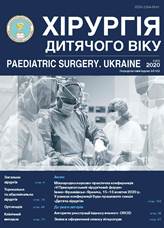mTOR Inhibitors in the complex treatment of high-risk vascular malformations in children
DOI:
https://doi.org/10.15574/PS.2020.67.6Keywords:
sirolimus, lymphatic malformation, complex vascular malformation, childrenAbstract
Recent experimental and clinical studies demonstrated that mTOR receptor inhibitors can stop the progression of vascular malformations and significantly improve patients’ quality of life. This is possible due to the interruption of the chain of phosphatidylinositol-3-kinase (PI3K) / AKT / mTOR reactions.
The purpose of the study is to assess the efficacy and safety of mTOR receptor inhibitors in children with high-risk vascular malformations.
Materials and methods. Six patients, from 1 to 9 years old, with extensive lymphatic malformations (n=3), complex slow-flow malformations – kaposiform lymphangiomatosis (n=1), Gorham-Stout disease (n=1), Klippel-Trenaunay syndrome (n=1), refractory to standard care, were enrolled in this study. Sirolimus was administered orally at initial dosage of 0.8 mg/m2/12 hour with pharmacokinetic-guided target serum concentration level of 5 to 10 ng/ml. The primary endpoints were safety and efficacy, based on clinical, laboratory and radiological evaluations.
Results. The duration of sirolimus treatment was from 6 to 24 months. All patients had improvement in one or more aspects of their diseases. It was relief of respiratory symptoms, stop of pleural effusion, normalization of blood coagulation parameters, discontinuation of bleeding and lymphorrhea, pain relief and as a result quality of life improvement. Radiological signs of treatment efficiency were reduction of the lesion size and stopping of the osteolysis. Sirolimus was well tolerated, with leucopenia (n=1), stomatitis (n=2), and dyslipidemia (n=2) adverse event. In no case was complete recovery of the patient observed, but there was no deterioration in the course of the disease.
Conclusions. Sirolimus was efficient in extensive LM and complex vascular malformations that were refractory to conventional treatments and was well tolerated.
The research was carried out in accordance with the principles of the Helsinki Declaration. The study protocol was approved by the Local Ethics Committee of all participating institution. The informed consent of the patient was obtained for conducting the studies.
References
Adams DM, Trenor CC 3rd, Hammill AM, Vinks AA et al. (2016). Efficacy and Safety of Sirolimus in the Treatment of Complicated Vascular Anomalies. Pediatrics.137(2): e20153257. https://doi.org/10.1542/peds.2015-3257; PMid:26783326 PMCid:PMC4732362
Baluk P, Yao LC, Flores JC, Choi D et al. (2017). Rapamycin reversal of VEGF-C-driven lymphatic anomalies in the respiratory tract. JCI Insight. 2: e90103. https://doi.org/10.1172/jci.insight.90103; PMid:28814666 PMCid:PMC5621869
Czechowicz JA, Long-Boyle JR, Rosbe KW, Mathes EF et al. (2018). Sirolimus for management of complex vascular anomalies – A proposed dosing regimen for very young infants. Int J Pediatr Otorhinolaryngol.105: 48-51. https://doi.org/10.1016/j.ijporl.2017.11.034; PMid:29447818
Flores MV, Hall CJ, Crosier KE, Crosier PS. (2010). Visualization of embryonic lymphangiogenesis advances the use of the zebrafish model for research in cancer and lymphatic pathologies. Dev Dyn. 239: 2128-2135. https://doi.org/10.1002/dvdy.22328; PMid:20549745
Hammer J, Seront E, Duez S et al. (2018). Sirolimus is efficacious in treatment for extensive and/or complex slow-flow vascular malformations: a monocentric prospective phase II study. Orphanet J Rare Dis. 29.13(1): 191. https://doi.org/10.1186/s13023-018-0934-z; PMid:30373605 PMCid:PMC6206885
Hammill AM, Wentzel M, Gupta A et al. (2011). Sirolimus for the treatment of complicated vascular anomalies in children. Pediatr Blood Cancer.57(6): 1018-1024. https://doi.org/10.1002/pbc.23124; PMid:21445948
Hartford CM, Ratain MJ. (2007). Rapamycin: something old, something new, sometimes borrowed and now renewed. Clin Pharmacol Ther. 82: 381-388. https://doi.org/10.1038/sj.clpt.6100317; PMid:17728765
Kobayashi S, Kishimoto T, Kamata S, Otsuka M et al. (2007). Rapamycin, a specific inhibitor of the mam- malian target of rapamycin, suppresses lymphangiogenesis and lymphatic metastasis. Cancer Sci. 98: 726-733. https://doi.org/10.1111/j.1349-7006.2007.00439.x; PMid:17425689
Lackner H, Karastaneva A, Schwinger W, Benesch M et al. (2015). Sirolimus for the treatment of children with various complicated vascular anomalies. Eur J Pediatr.174(12): 1579-84. https://doi.org/10.1007/s00431-015-2572-y; PMid:26040705
Luks VL, Kamitaki N, Vivero MP et al. (2015). Lymphatic and other vascular malformative/overgrowth disorders are caused by somatic mutations in PIK3CA. J Pediatr. 166(4): 1048-54. e1–5. https://doi.org/10.1016/j.jpeds.2014.12.069; PMid:25681199 PMCid:PMC4498659
Martinez-Lopez A, Salvador-Rodriguez L, Montero-Vilchez T, Molina-Leyva A et al. (2019). Vascular malformations syndromes: an update. Curr Opin Pediatr.31(6): 747-753. https://doi.org/10.1097/MOP.0000000000000812; PMid:31693582
Mizuno T, Emoto C, Fukuda T, Hammill AM et al. (2017). Model-based precision dosing of sirolimus in pediatric patients with vascular anomalies. Eur J Pharm Sci.(15).109S: S124-S131. https://doi.org/10.1016/j.ejps.2017.05.037; PMid:28526601
Nadal M, Giraudeau B, Tavernier E, Jonville-Bera AP et al. (2016). Efficacy and Safety of Mammalian Target of Rapamycin Inhibitors in Vascular Anomalies: A Systematic Review. Acta Derm Venereol.96(4): 448-52. https://doi.org/10.2340/00015555-2300; PMid:26607948
Osborn AJ, Dickie P, Neilson DE, Glaser K et al. (2015). Activating PIK3CA alleles and lymphangiogenic phenotype of lymphatic endothelial cells isolated from lymphatic malformations. Hum Mol Genet.24(4): 926-938. https://doi.org/10.1093/hmg/ddu505; PMid:25292196
Ozeki M, Fukao T. (2019). Generalized Lymphatic Anomaly and Gorham-Stout Disease: Overview and Recent Insights. Adv Wound Care (New Rochelle). 1;8(6): 230-245. https://doi.org/10.1089/wound.2018.0850; PMid:31236308 PMCid:PMC6589502
Vignot S, Faivre S, Aguirre D, Raymond E. (2005). mTOR-targeted therapy of cancer with rapamycin derivatives. Ann Oncol. 16(4): 525-537. https://doi.org/10.1093/annonc/mdi113; PMid:15728109
Ying H, Qiao C, Yang X, Lin X. (2018). A Case Report of 2 Sirolimus-Related Deaths Among Infants With Kaposiform Hemangioendotheliomas. Pediatrics.141(5): S425-S429. https://doi.org/10.1542/peds.2016-2919; PMid:29610165
Downloads
Published
Issue
Section
License
The policy of the Journal “PAEDIATRIC SURGERY. UKRAINE” is compatible with the vast majority of funders' of open access and self-archiving policies. The journal provides immediate open access route being convinced that everyone – not only scientists - can benefit from research results, and publishes articles exclusively under open access distribution, with a Creative Commons Attribution-Noncommercial 4.0 international license(СС BY-NC).
Authors transfer the copyright to the Journal “PAEDIATRIC SURGERY.UKRAINE” when the manuscript is accepted for publication. Authors declare that this manuscript has not been published nor is under simultaneous consideration for publication elsewhere. After publication, the articles become freely available on-line to the public.
Readers have the right to use, distribute, and reproduce articles in any medium, provided the articles and the journal are properly cited.
The use of published materials for commercial purposes is strongly prohibited.

